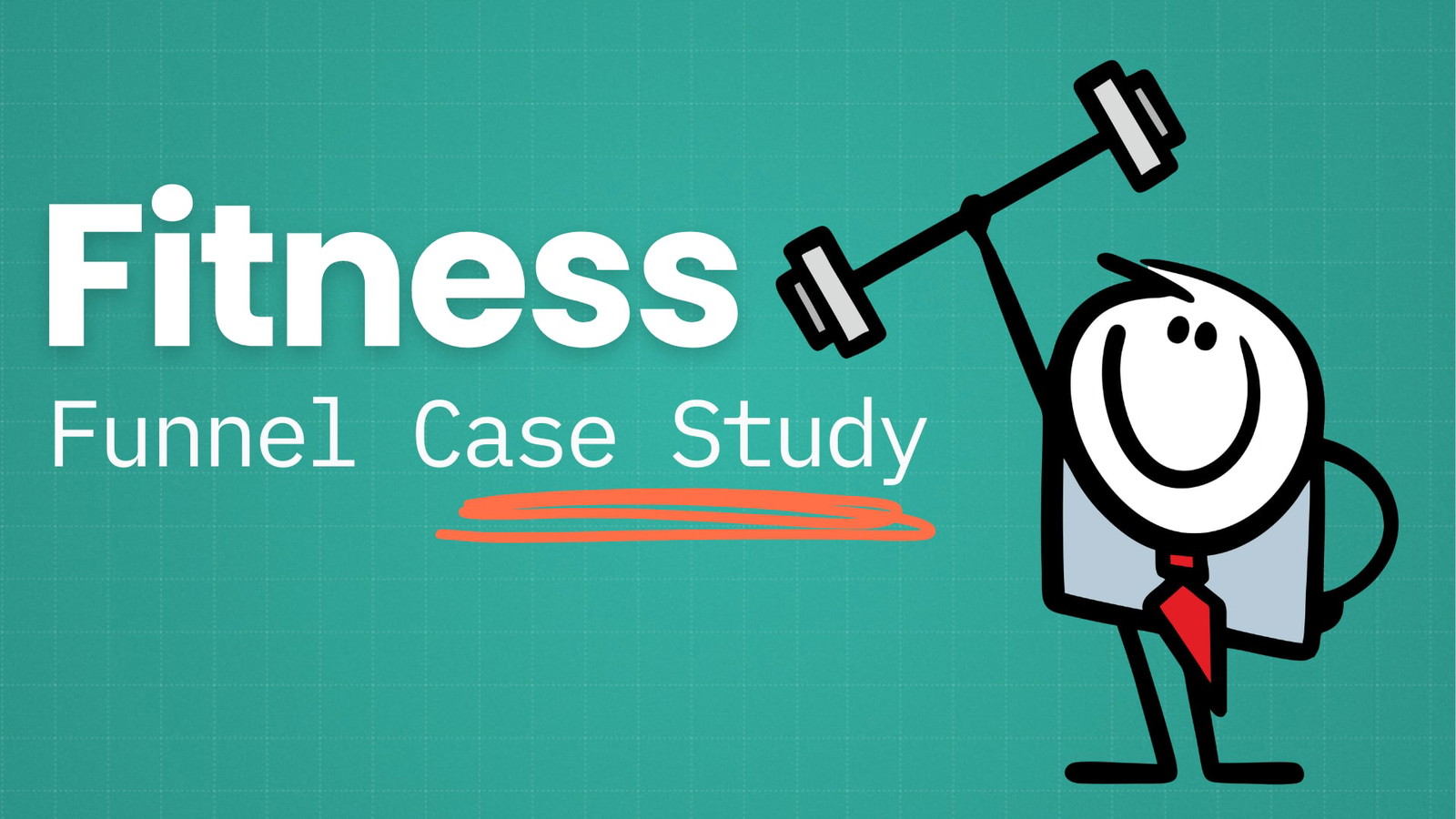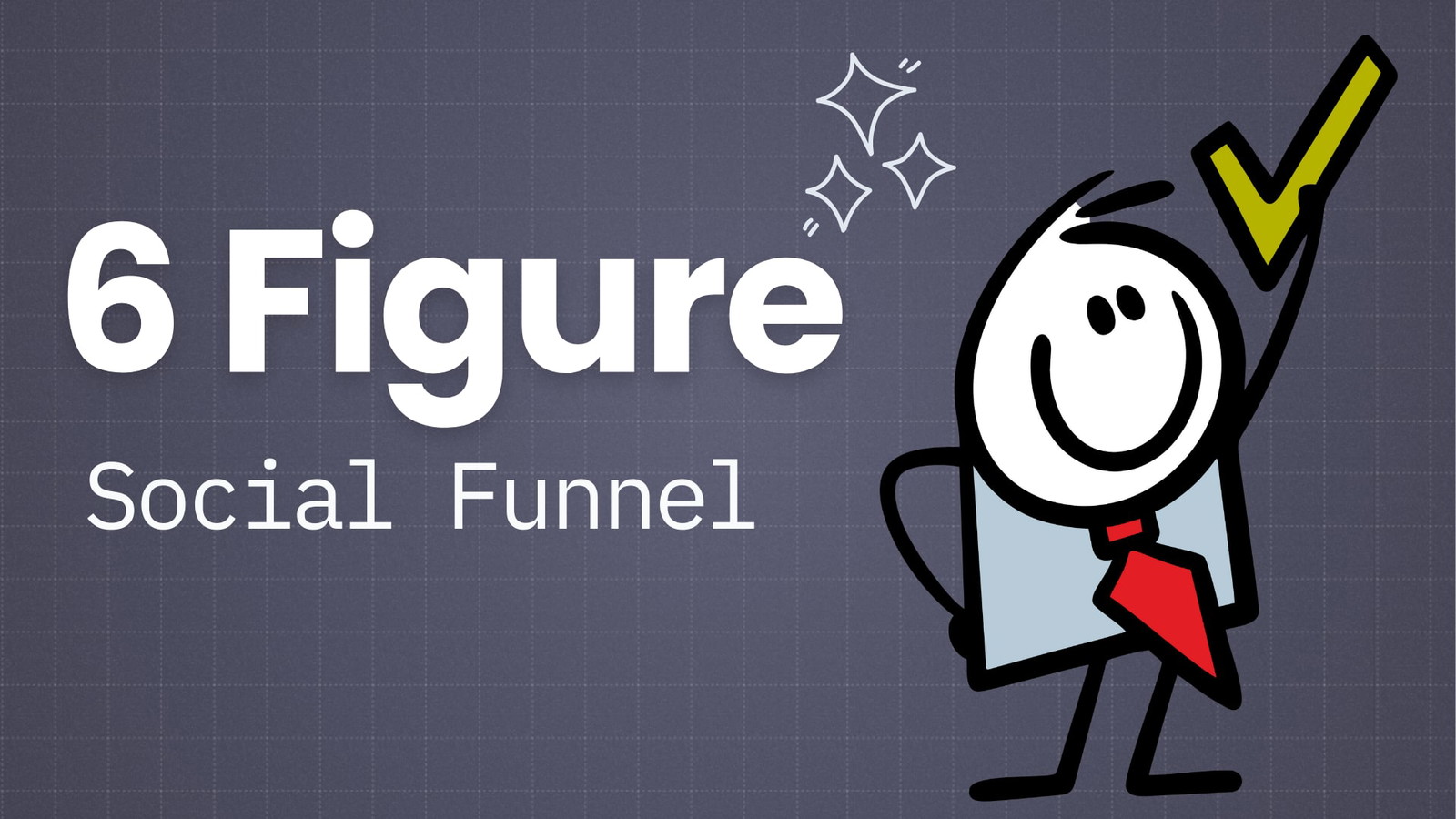Without a reasonably good headline, nobody will bother to read your content.
That makes the headline the most important part of it.
It sucks to say, but to be perfectly on point, writing a good headline even beats writing great content itself, as bad content gets most exposure these days because of better headlines.
Plus, it’s much easier to write a catchy headline than it is to put a great piece of content together.
Ask most newspapers.
And, even if you are a hardcore SEO person who thinks this social media B.S doesn’t apply to you, you are wrong.
Headlines and clickable titles are important for several reasons:
- You can use the science of creating great headlines to improve your title tags and get higher CTR in search
- Higher CTR in search has been linked to higher rankings
- There is a HUGE correlation between content that gets shares and content that gets links and organic traffic (and shares are mostly based on the headline as data will show you soon)
So even if you are an SEO and want something that will give you an edge over the competition, read on.
Additionally, the knowledge we have put in this article can be used for:
- Blog posts title writing
- Facebook ads and other social media ads
- Email marketing
- Push notifications
- Social media
- Email outreach
- Job ads posting
And pretty much anything else that has a headline.
We analyzed 1.5 million heavily shared headlines so we can put together a straightforward guide to write solid headlines.
Before you go on and read about how to write actually useful headlines, here’s a short overview of the actual findings:
- 10% of content gets 90% of social shares and social engagements (likes, comments, retweets.
- If you break it down further the 1% of the most shared content gets over 50% of all shares and social engagements.
- Content that’s shared a lot also gets 2-5x more organic traffic and backlinks, even though these metrics are likely interdependent.
- Longer headlines tend to do better on social media than shorter headlines.
- Some topics deliver success – while polarizing topics dominate the top performing headlines, appealing to self-interest. Basic needs, emotions, etc. seems to work too.
- Credibility and authority sell.
- The headlines of the most shared content are less positive in tone than the average.
- Marketing power words are quite a myth. Using some makes your headlines better, while others are total garbage.
So that’s for a quick glimpse. Now, onto the actionable stuff.
How We Scraped 1.5 Million Headlines for This Study
It is said that successful marketers spend up to 60% of their time on the headline alone, surprisingly there’s little data behind the science of writing it.
A couple of good studies were done in recent years, one by Buzzsumo, another one by CoSchedule, both companies in the business of content marketing.
Both of these studies are great and served as an inspiration for this one.
We took a slightly different approach, however.
First, we obtained 1.5 million headlines that were quite heavily shared.
We looked at Facebook, Twitter, and Reddit (now the 5th most visited website in the US.)

Note
We focused on getting 1.5 million headlines that already had some meaningful social scores.
There’s little utility in getting an entirely random dataset as most content gets no shares, so you only end up with a small number of “top performers” getting statistically meaningless data.
We used Ahrefs’ Content Explorer, Ahrefs’s API, Reddit, and Twitter APIs to obtain our data (stats like shares, traffic, type of content, referring domains, etc.)
The data were cleaned up, outliers and duplicates removed.
Another thing we did differently is that we broke it all down into the top 20%, top 10%, top 5%, and top 1%.
Threshold Scores
| Top 20% | Top 10% | Top 5% | Top 1% | |
|---|---|---|---|---|
| 945 | 3,016 | 7,756 | 43,303 | |
| Reddit (links only) | 610 | 1,857 | 4,136 | 17,716 |
| 42 | 98 | 214 | 1,188 |
Instead of simply looking at factors present among the most shared headlines, we made sure the presence factors increased as we moved up towards the top 1%.
Anyway, let’s look at those findings.
The 1% of Social Media
I’m quite fascinated by the Pareto Rule. Also known as the Law of the Vital Few or the idea that most (80-90%) effects come from a few (10-20%) causes.
This has been proven valid across many disciplines and so it is with social sharing.
In our dataset, 20% of headlines get 95% of all shares and social interactions. As we mostly looked at headlines that do get shared, it’s safe to say that general distribution is even more ‘unfair,’ if we include all the headlines with zero or minimal stats.
It gets more interesting. To make sure we identified “the vital few” we broke it down further. It turns out the top 10% gets almost 90% of all shares and the top 5% gets about 70% of it.
Social Engagements Owned
| Top 20% | Top 10% | Top 5% | Top 1% | |
|---|---|---|---|---|
| 95.16% | 88.32% | 78.57% | 51.02% | |
| Reddit (links only) | 88.25% | 76.86% | 61.79% | 23.91% |
| 92.21% | 84.81% | 76.44% | 54.98% |
If you are a marketer it’s always good to break things down further. You’ll find what gives the maximum output and then focus on that in your marketing efforts.
To be clear, you can take the top 5% of top performers and find out that the Pareto Rule applies there too. For example, 20% of the top 5% would likely get 80% of all its shares.
Again, it is the case headlines too, as the top 1% gets half of all shares.
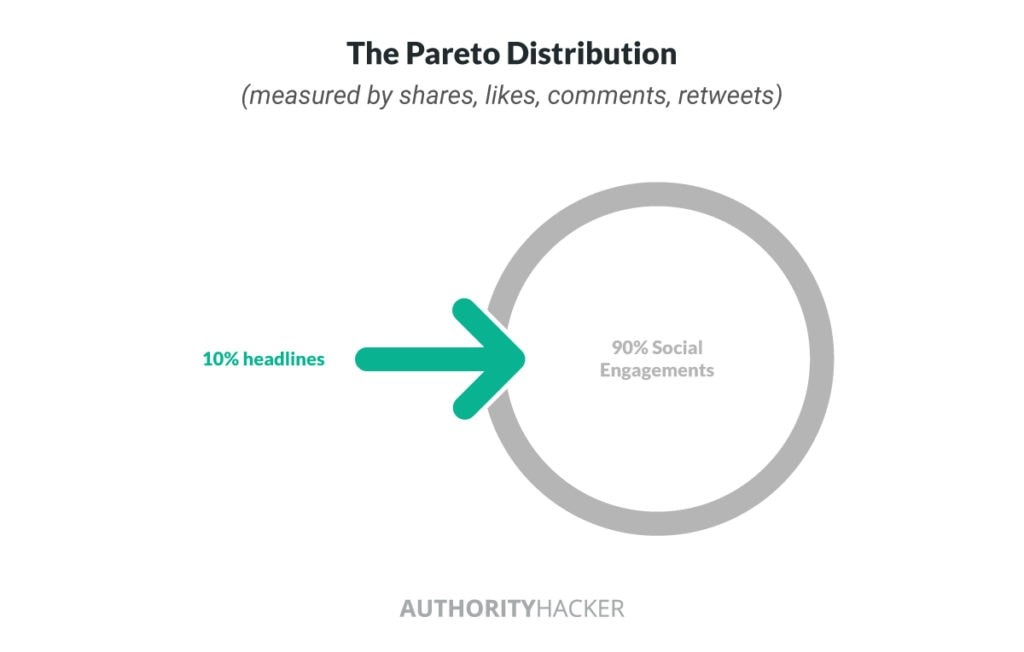
The next question to ask was: what’s the role of headlines in the sharing process?
Most Social Shares Come from People Who Only Read Headlines
There is a famous saying from the legend of copywriting, Gene Schwartz that the purpose of the headline is to get you to read the first sentence.
And the purpose of the first sentence is to get you to read the second one.
In content marketing, the significance of it goes even beyond that.
At least 59% of social shares and engagements come from people who only read the headline and never bothered to read a single sentence.
This is what a study from Inria on 2.8 million Twitter shares and 9.6 million clicks found out.
So even if your content is mediocre but your headline is great, most people who share it won’t even notice.
Gael’s Note
So why the hell am I editing this piece right now??
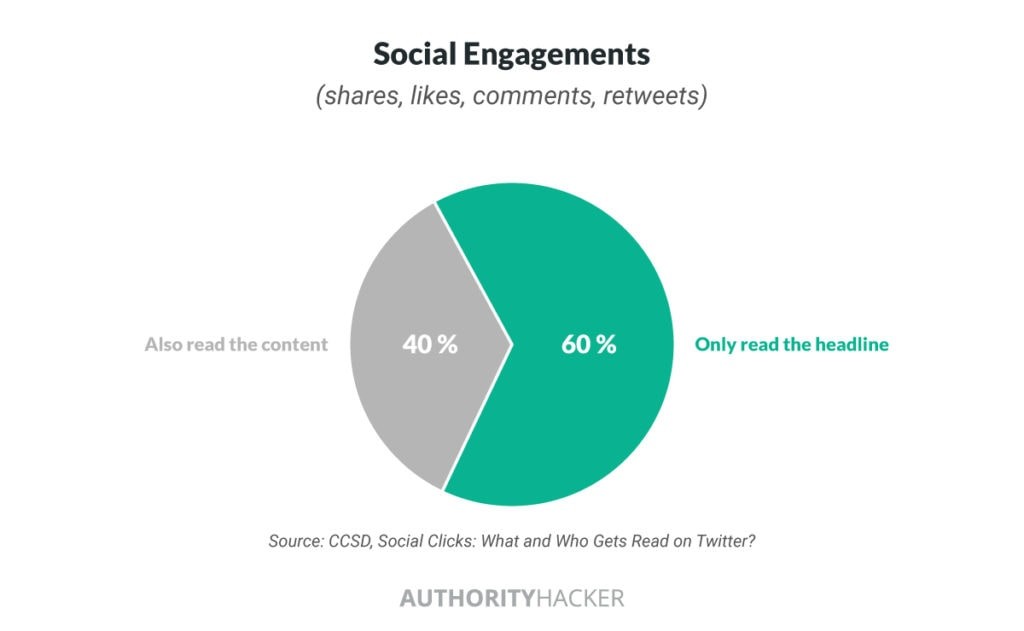
Shares Highly Correlate With Links and Organic Traffic
Here it gets interesting.
Most people in our circles disregard social media success because it is seen as short-lived and just a lot of hassle compared to search traffic.
But if you look at the organic traffic of the top shared pieces, social success seems to correlate with search traffic.
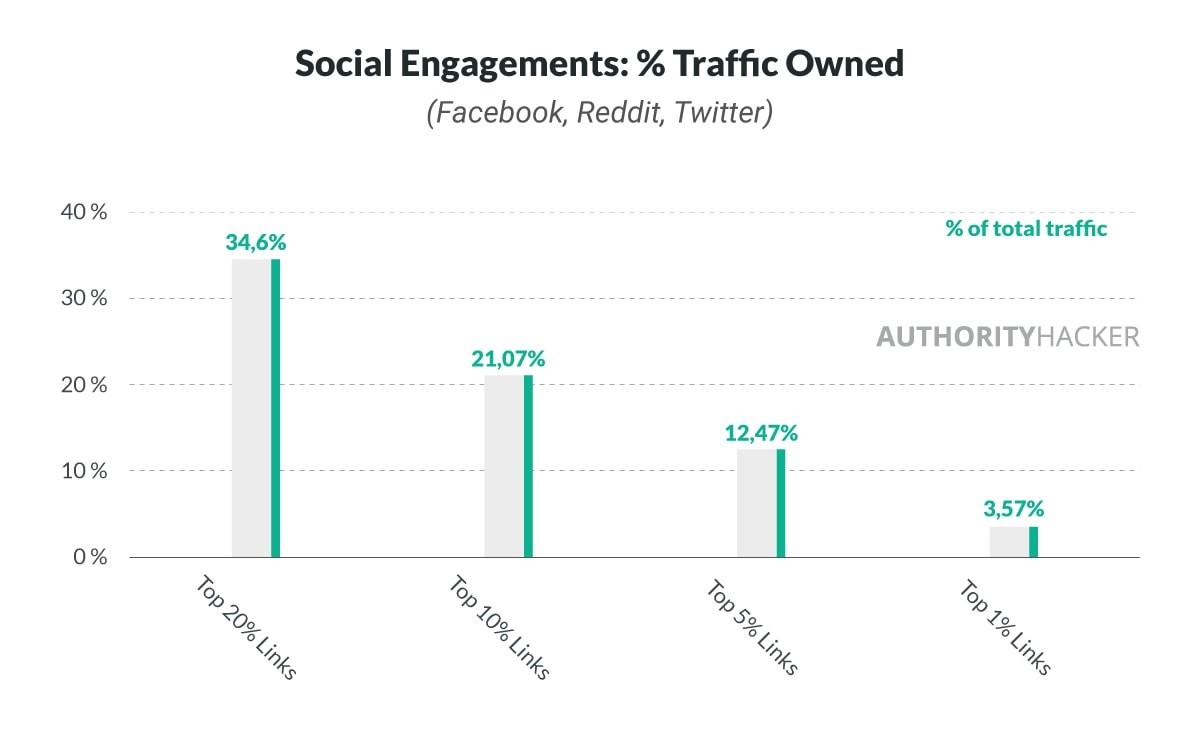
As you can see, the top 10% of shared content gets about two times or 200% more traffic than the average.
And the top 1% gets 357% more traffic than the average.
That’s great but also not earth shattering.
It shows that being a hit on social media doesn’t make you a rockstar in terms of SEO either and that most likely there are content formats that do better in social and some that do better in search.
Oh yeah, also, correlation is not causation folks.
Now, Here is a look at backlinks (measured by the number of referring domains):
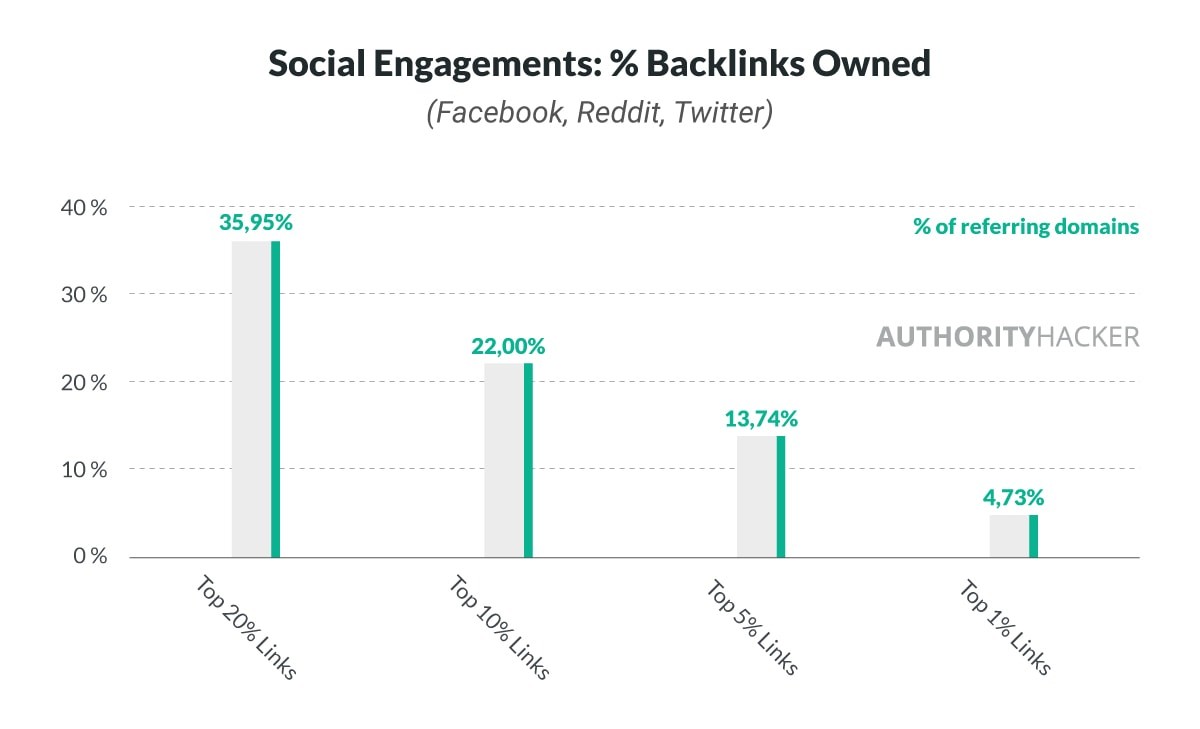
Again quite impressive. As you know from our SERPs study the number of referring domains is the single most important SEO factor.
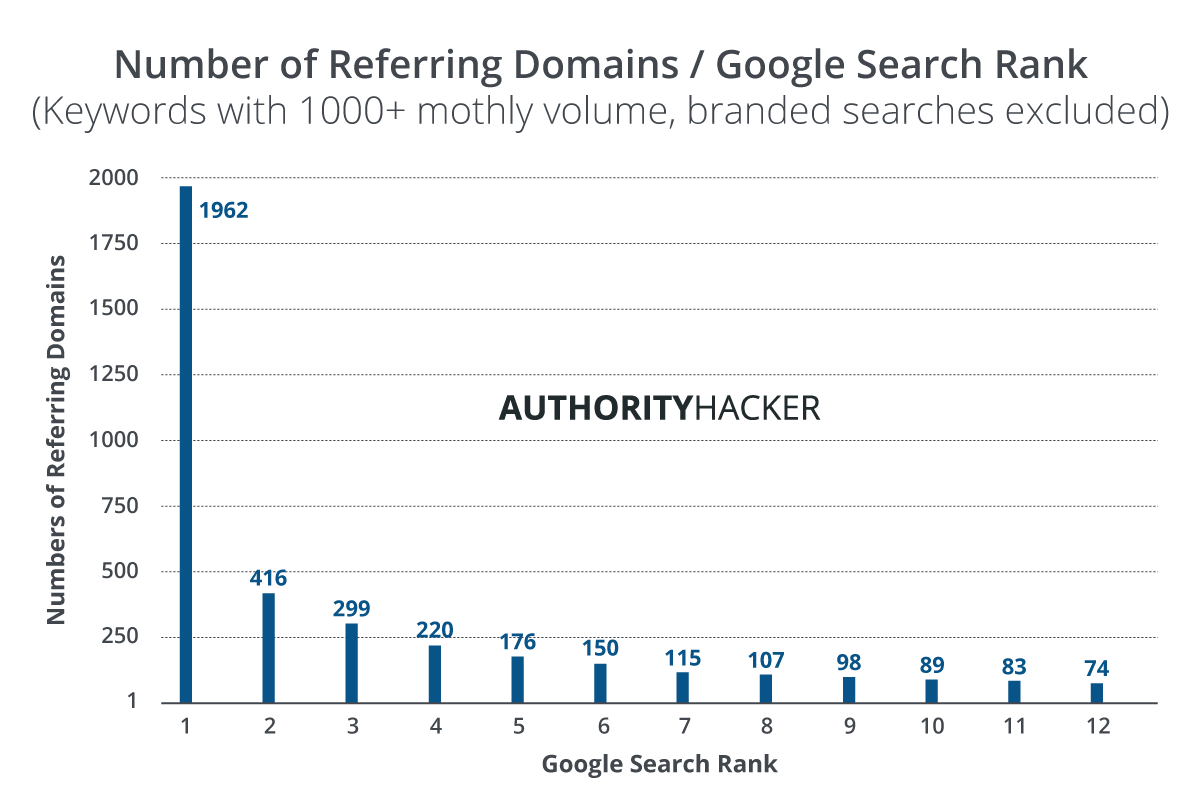
Now, I don’t know what’s the relation between shares, backlinks, and traffic but most likely they feed off each other – i.e. shares get traffic, traffic gets links, links get more traffic, more traffic gets more shares.
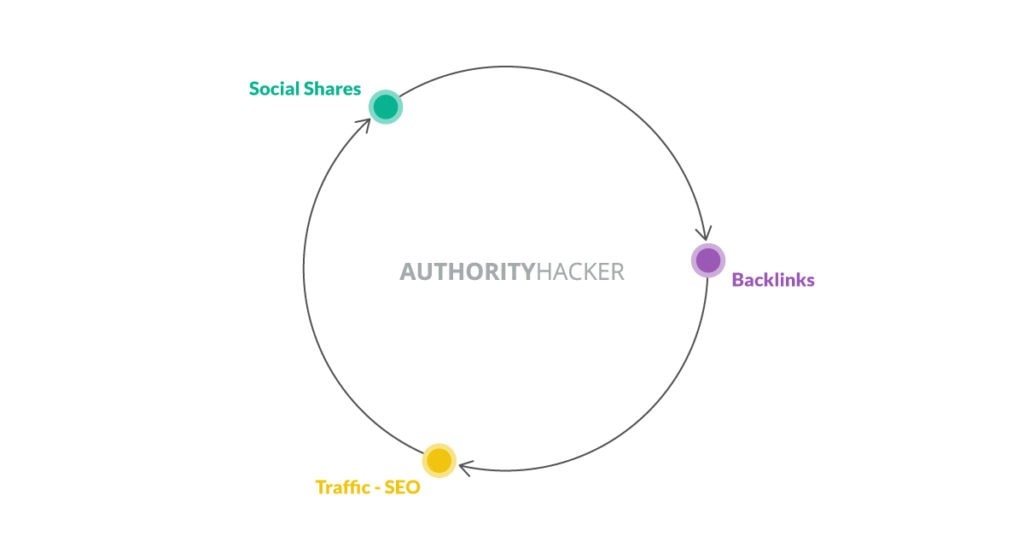
Our Experience
Now the question you are probably asking is:
Do these learnings apply to smaller publishers like most of us are? Or is it just something for massive media conglomerates?
Here is the tale of a site we haven’t shared publicly before.
This site has only been actively promoted using Pinterest.
It has done really quite well on the platform with some posts collecting over 100,000 shares.

The content is rather thin compared to our standards, but the headlines are clickbaitsy which probably explains the number of social shares we have collected.
We did not expect this site to take off in Google because the content wasn’t really crafted for it and yet that site is now ranking on top of many fairly large keywords even taking a lot of featured snippets:
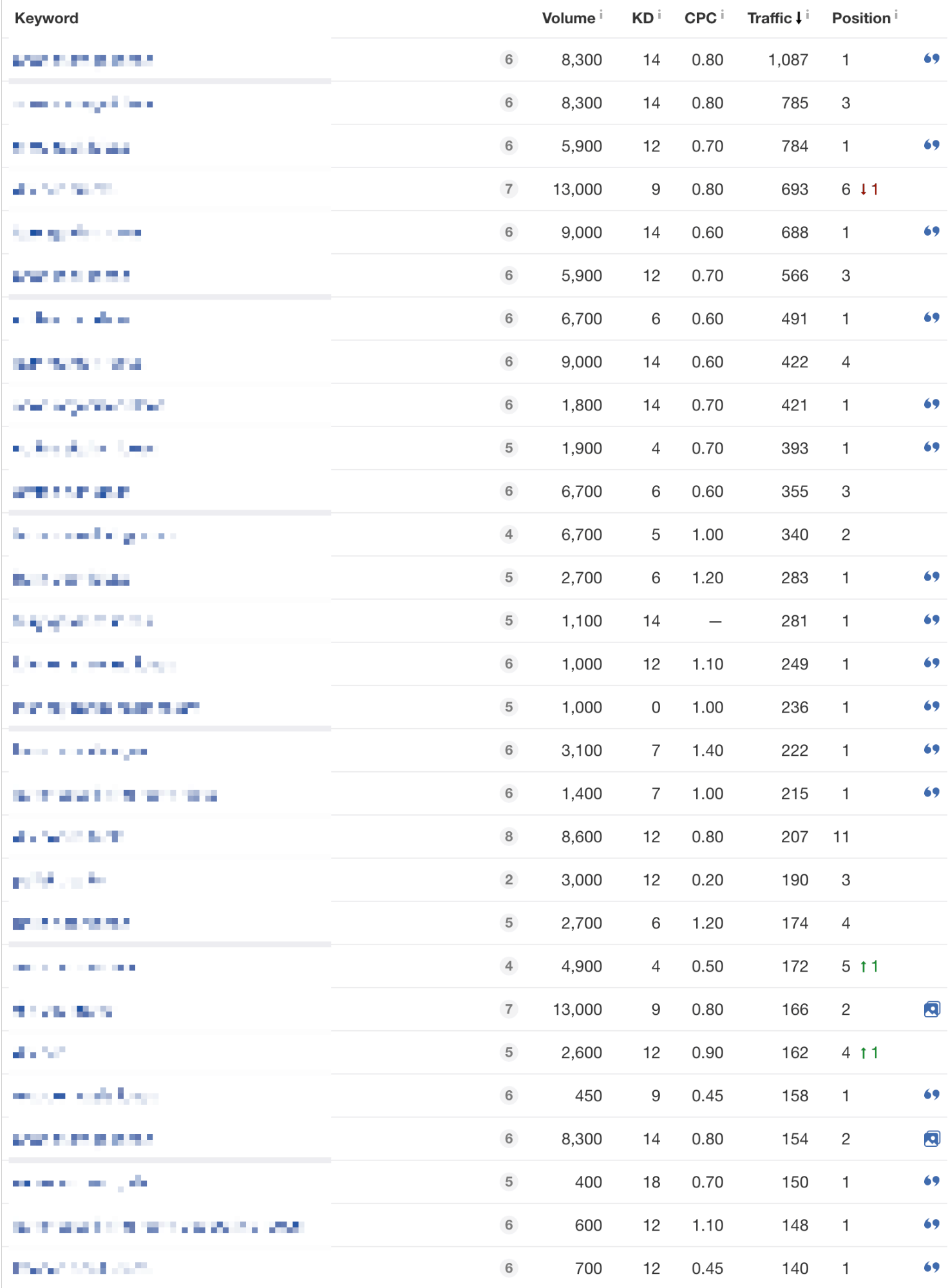
And despite the fact that we have done absolutely no link building, the site now sits are 835 referring domains including several DR 80+ links:
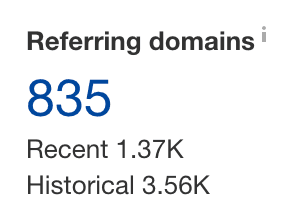
These links were most likely acquired through people discovering the content on Pinterest and linking to it which pushed the rankings up.
So can all this stuff work in real life and push your site up?
Yes, it can.
Key takeaways:
It’s quite interesting to see how shares, feed backlinks that then feed search traffic. It’s almost like social shares, despite the fact that they may not be a ranking factor, can influence your rankings.
So if you want to achieve the highest levels in SEO, you need good social sharing levels.
And as we saw previously, most shares happen ONLY based on the headline (most people don’t even consume the content).
Therefore, even excluding factors like search click-through rate, a great headline can probably be considered a very indirect ranking factor.
Now, let’s dive into what makes headlines better and how you can use these tactics for your own business.
Longer Headlines Perform Better
Length of a headline is positively correlated with social media success. The average length for the 1% top performing headlines is 11.6 words and 70 characters.
When compared to the remaining 99% of all content those figures mean that most shared headlines are about 10% longer.
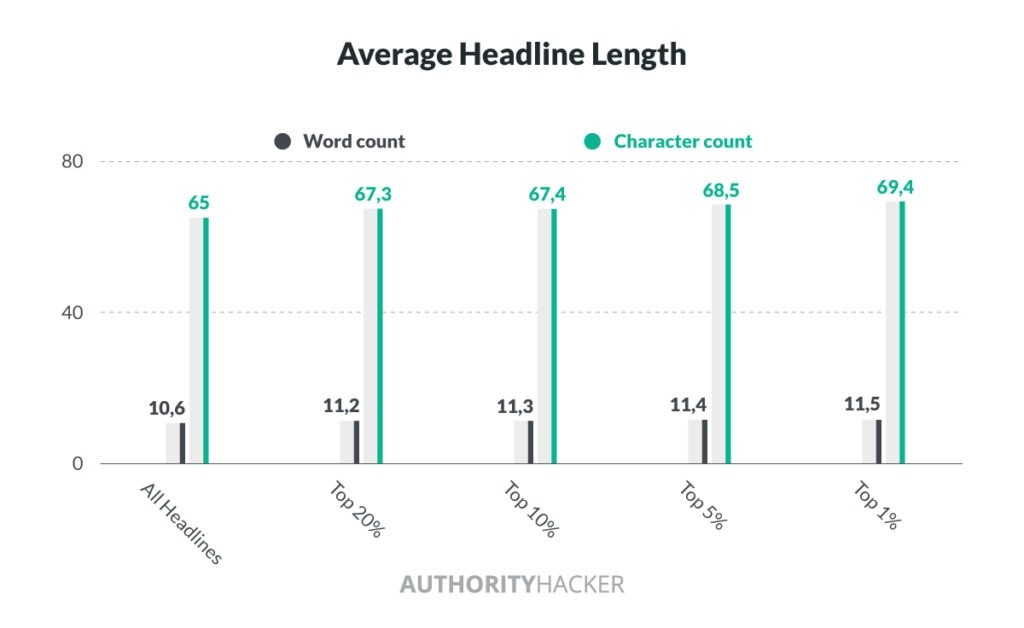
If we break it down per social network it gets more interesting. The length matters a lot for Facebook, but the differences are much smaller when it comes to Twitter.
Word Count
| Top 20% | Bottom 80% | Top 10% | Bottom 90% | Top 5% | Bottom 95% | Top 1% | Bottom 99% | |
|---|---|---|---|---|---|---|---|---|
| 11.3 | 10.4 | 11.4 | 10.5 | 11.5 | 10.6 | 11.6 | 10.6 | |
| 11.1 | 10.5 | 11.1 | 10.5 | 11.1 | 10.6 | 11.1 | 10.6 | |
| 14.8 | 13.1 | 15.4 | 13.3 | 16.1 | 13.3 | 19.5 | 13.4 |
Character Count
| Top 20% | Bottom 80% | Top 10% | Bottom 90% | Top 5% | Bottom 95% | Top 1% | Bottom 99% | |
|---|---|---|---|---|---|---|---|---|
| 68.4 | 63.7 | 69.3 | 64.1 | 69.8 | 64.3 | 70.4 | 64.6 | |
| 67.6 | 63.7 | 67.6 | 64.3 | 68.9 | 64.4 | 66.1 | 64.6 | |
| 89.0 | 79.8 | 92.1 | 80.5 | 96.9 | 80.8 | 118.9 | 81.3 |
Obviously, there’s a limit to how long a headline can be to be displayed properly. For Twitter in particular as there’s a limit of 140 characters (recently increased to 280).
Naturally, the URL will take up some space (unshortened the average length for the URLs in our dataset was 90 characters) and then you’ll want to have one or two hashtags.
As you can see, the limits are much more loose for Reddit. The average length for the 1% of top performing URL submissions is 19.5 words or 119 characters.
That can be easily explained by the nature of Reddit itself, as the way it is designed allows longer headlines to occupy more screen space.

This makes the headline more visible, grabbing more attention with more space to click on.
Key takeaways:
Writing a headline that is close to the maximum character count of the network you share it in will generate more shares and click through rate.
Fortunately, there is a way to write different headlines for the most important social networks using special meta tags.
Facebook and several other networks like Pinterest use OG (open graph) tags.
Twitter uses Twitter cards tag.
Here is an example of a recent post on this site and how we use social tags to show different headlines on different networks:
On post headline:
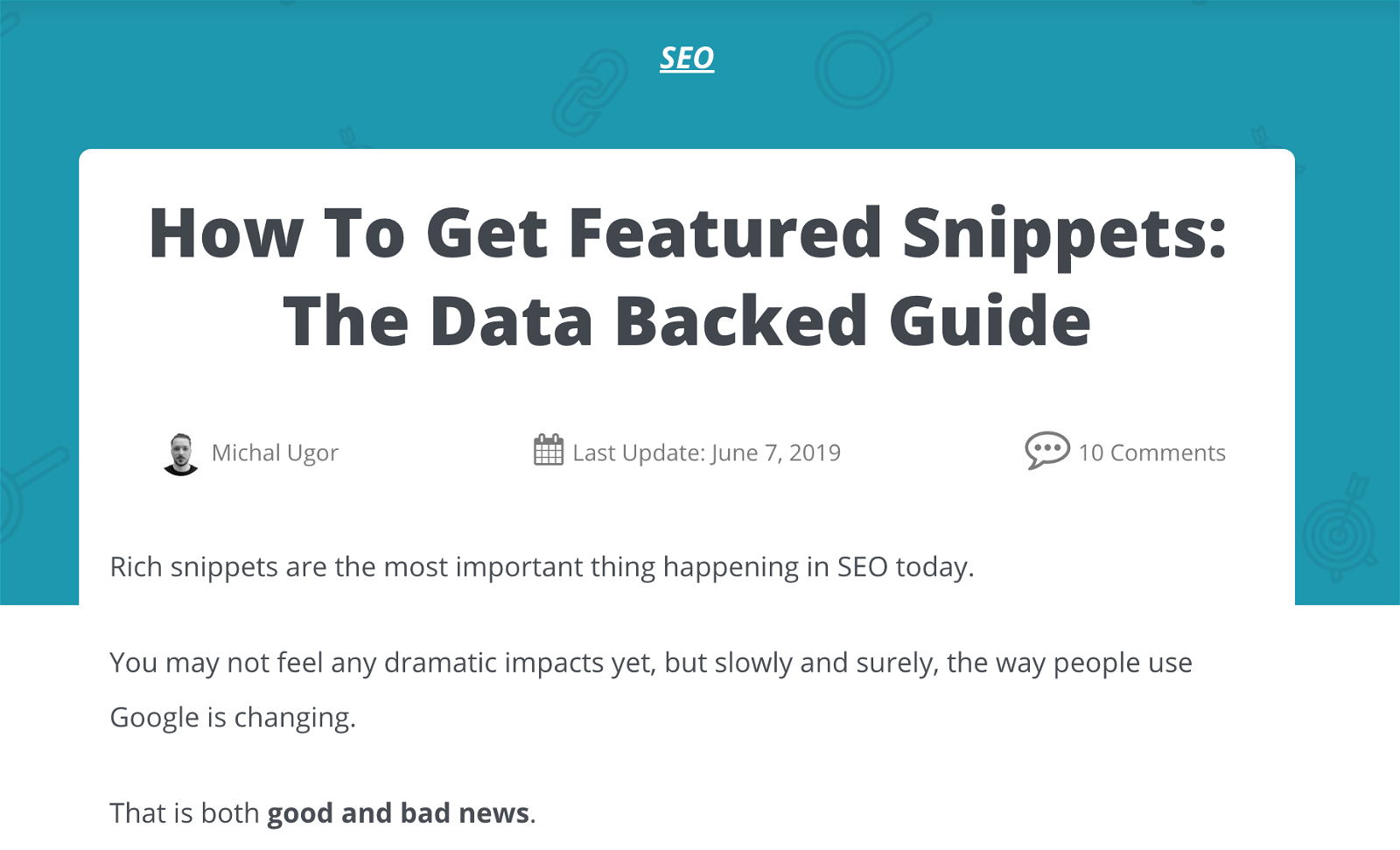
Facebook headline:

Twitter headline:

What is great about these social tags is that these headlines are not just used when YOU share the content.
They are used when ANYONE shares the content.
So you get a permanent organic social boost by using them.
Luckily, most SEO and social media Wordpress plugins have made this easy.
Here is how it looks inside the Dashboard using SEOPress (it’s similar on Yoast if that’s what you use):
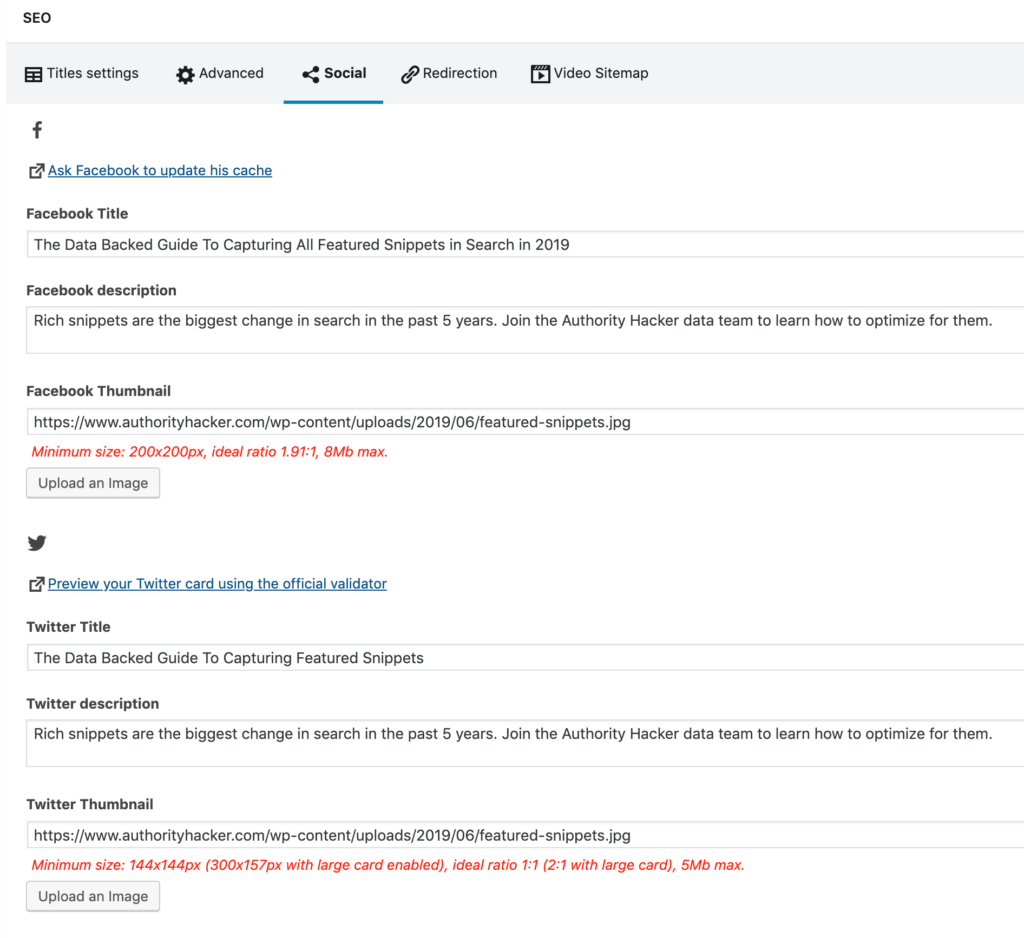
The best way to use this is to write custom titles for each network after you published the page and use the test tools linked above to make sure they look clean and use the tactics we will discuss below to optimize ctr and share rate.
9 Headline Recipes That Dominate Attention
Alright, so now we know the optimal length of a headline that you should aim for. Let’s find out about its contents.
We analyzed all of our headlines and searched for words and phrases that increasingly occur in the higher performing segments.
And guess what was the winning keyword?
Trump.
This single keyword was so dominant it even beat most pronouns, conjunctions, prepositions (such as is, on, at, it, are, you, from, that, as, us, this) which are commonly present.
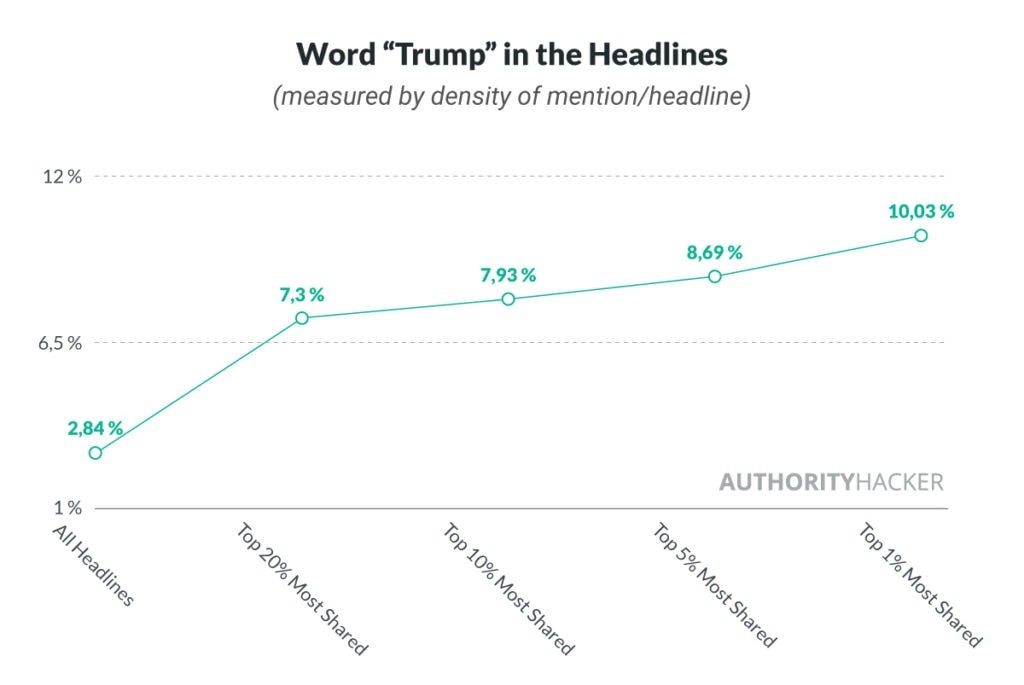
Note
As you can see, these are strong correlations. Other studies just looked at the top performers and said: “they contain these words the most.”
That’s useless because some words, while frequent among top performers, we found to be equally or even more frequent in the general sample.
For example, the number 10 is the most frequent number among the top performing headlines. But overall, it’s less frequent than what you find in all headlines.
It’s just that headlines with “10” are very frequent overall. So it is with many others.
We only considered words and phrases that were increasingly overrepresented as we moved from the general sample to the top 20%, 10%, 5% and finally the top 1%.
Does that mean your headlines should contain the word Trump?
It may help, but that’s not the point.
Most of these words may be connected to the news of the moment. For example, the word “black” showed up higher than it normally would mainly due to the recent black hole pictures taken by scientists.

What we can actually learn are the topics that people are reacting to.
Most marketers know that when it comes to advertising, there are some headline recipes that seem to hit more than others. Those include controversies, basic needs, emotions and so on.
We tried to map these out below:

It was hard to categorize everything. Some words are just too general. What we discovered is many words are associated with the content format itself.
For example the word “shows” most commonly occurs when the post prominently features a video. That’s why it was marked as entertainment.
Here are words with the highest correlations:

Now let’s look at how we can use this information to craft headlines archetypes that are sure to generate high share and click through rate.
#1. Use Politics, Controversial and Divising Topics to Boost Your Headline’s Popularity
Most keywords fall into this category. And it’s not the most important political topics, but rather the most divisive.
Consider that the two highly overrepresented politicians in the headlines are Trump and Ocasio-Cortez. You won’t find more divisive figures in the US politics today.

The other topics include climate change, race, sex, and immigration.
For example, the most common form in which the word “wall” occurs is “border wall.” For food, it’s “food stamps.” For white it’s “white people,” for bill it’s “abortion bill” and so on.

These topics spike emotions and, once again, we can confirm that it’s the emotions that drive our attention the most.
This means that newsjacking and covering any kind of legal change or mention of your industry on your blog is a huge opportunity for shares, links and other positive signals even if your topic is not super related as the guys from Vice teach us.
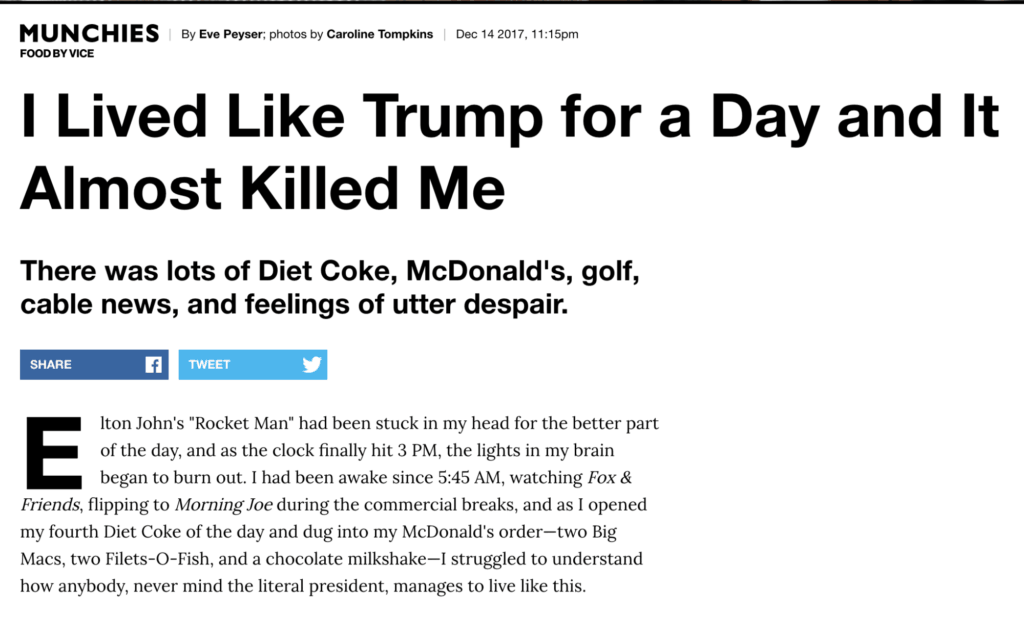
#2. Write About What Other People Do, Think, Eat, Shit
Another thing that fairly known in marketing and advertising is that people are curious about other people. Who does what and so on.

That explains the high rates of words like “his,” “her,” “him,” “who,” “she” and so on. Basically, pronouns related to reading stuff about other people (politicians, celebrities).
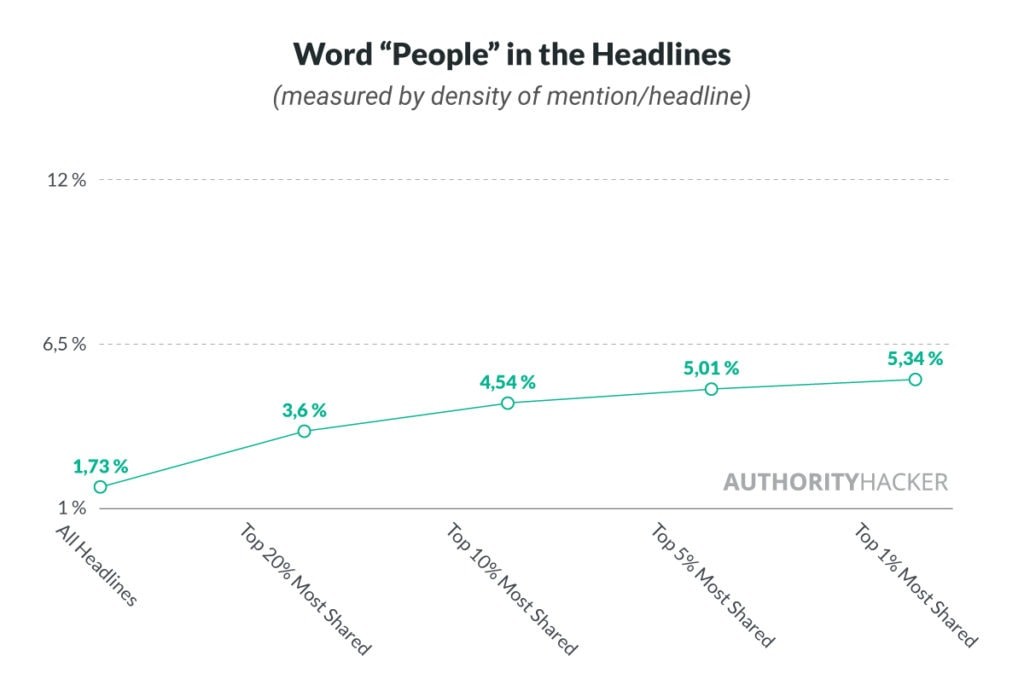
Aside from ourselves, we care about social groups we belong to and, in general, what other people think and do as our brains are designed to seek social relatedness.

This explains high scores for words like “people”, “Americans,” “families,” “friends.”
#3. Make a Link With Current Mass Entertainment
This is not surprising. Most people use social media for entertainment or to procrastinate, seek distractions or simply waste time.
How many Game of Thrones related articles did you have to brace through during the final season?
It looks like even SEO’s gave it a shot.

In general, words like “video,” “watch,” “viral,” “gifs,” “artist,” “Hollywood” all turned out to be highly correlated with social engagements.

It also seems k-pop is the hot thing these days, or at least in the recent months as two words that scored very high rater were BTS and Blackpink. These are k-pop groups.
#4. Write an Overly Emotional Headline
As stated before we’re driven by emotions. It seems we’re more driven by negative emotions than positive ones.

Words charged with negative emotions, like “dead,” “police,” “against,” “killed,” “dies,” “cancer” etc. are more present among the highly shared headline.

From the positive emotions keywords, we found the highest correlations with “kids”, “dog” and “baby/babies”.
#5. Health, Wealth & Relationships
These topics concern everyone and therefore boost the shareability of your content.
These include everything related to work, family, health, money and so on. An interesting observation was the high score of “keto” or “keto diet.”

One easy way to implement these in your headlines is to talk about the benefits of what you are talking about so let’s say you have an article about the benefits of Spinach then make sure you link it to how it’s going to help people lose weight.
#6. List Posts and the Most Engaging Numbers
List posts have always generated tons of social engagements. That’s because you know what to expect and they’re easy to read, which goes well with social media.

Previous studies have established the number 10 to be the most engaging number in the headlines.
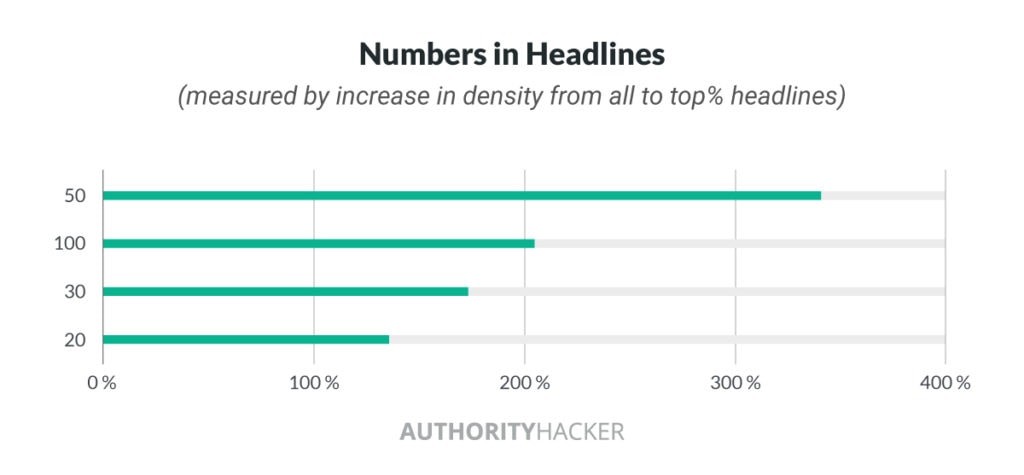
This didn’t prove to be the case. The number 10 showed negative progression, same for the numbers 5 and 3. It turned out, it’s the numbers 50, 20, 30 and 100 that correlate well.
The number 50, however, seemed to be overrepresented with the help of compromised “50 million Facebook accounts” that made the headlines in a big way.
#7. Study Finds …
I consider this to be a very valuable finding. It seems that establishing credibility right in the headline pays off a lot.
Words like “study,” “scientist/s,” “report,” all showed high correlations with social engagements. It seems people are hungry for facts and value the perceived credibility.
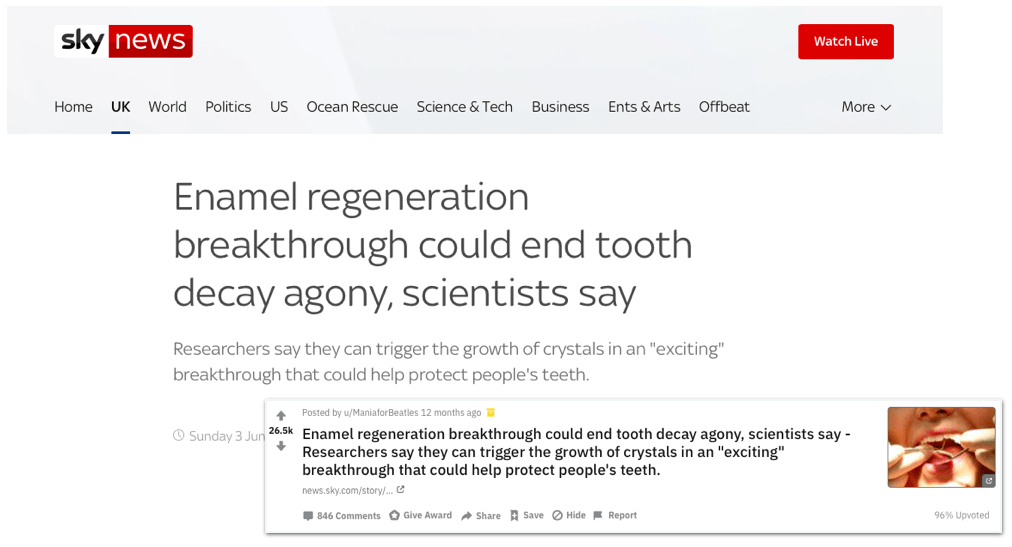
All these words appeared in formats like “new study finds,” “scientists say,” “new report says” as the most common. However, the word “research,” didn’t correlate well.
Interestingly, the most common format for another highly engaging word “news” ends up being the “fake news” while the word “fake” scored high levels too.
#8. Speak With Certainty and Authority
Another rule well known to most copywriters is to write with authority. The way to convey authority in your copy is by using words like “will” instead of “may,” “might” or “should” and “can” instead of “could.”
Both “will” and “can” correlate positively, while words like “might” or “could” correlate negatively with social engagement scores.

We observed that not from the counts alone but rather from the full phrases such as “you can” and “this will” that are overrepresented too.
This one is quite interesting as it can easily explain why a lot of articles are labeled as fake news or bad journalism.
If publications want to get more shares and links, they have to be definitive on what they say.
There is no space for nuance on social media.
#9. Other Angles
A bunch of other interesting stuff includes the word “awesome” which seems to show very positive effects on headline sharing.
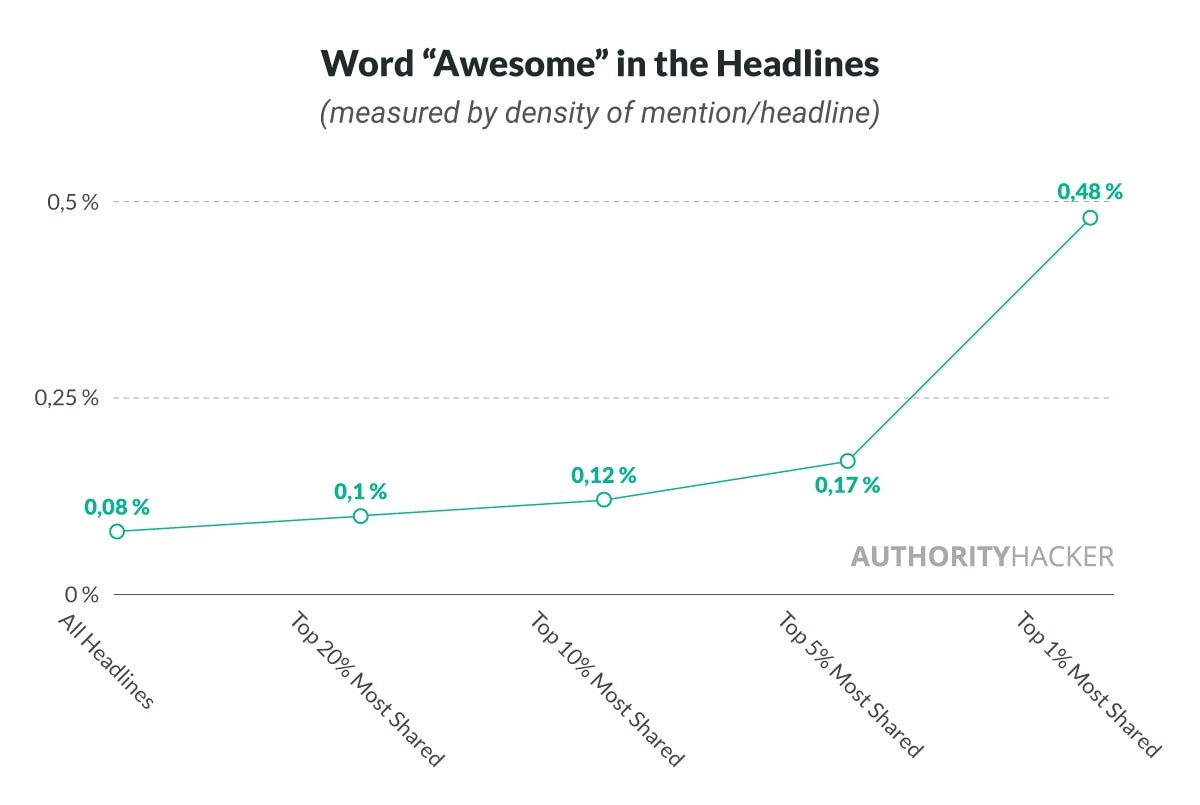
A great deal however comes from the popularity of funny gifs shared via website gfycat.com that go by the headline “[random] – Create, Discover and Share Awesome GIFs.”
So aside from the word “awesome” this is also a testimony to the popularity of gifs.
Then there are words “million” and “billion.” It can be that they carry certain weight with them like “power words,” i.e. the word “awesome.”

Then there are words that relate some urgency or novelty like “now,” “just,” and “official,” which appears most commonly as “it’s official.”
The less surprising are words “you” (everyone cares about themselves) and “sex.”
Key Takeaways:
Try to implement these topics in your headlines and see how they do (headline testing method below). Be creative. You don’t have to become BuzzFeed.
Write your headlines with authority and highlight their credibility. Appeal to your reader’s self-interest. Know what emotions to spike and use appropriate positive or negative words.
I.e. if you’re running a blog about zen meditation for women, use more of the words like “love,” “kids,” “dog” and so on.
Polarity and Subjectivity
As the previous section suggests polarized headlines seem to be doing way better than the average.
I wanted to get more insight into that so I ran the whole dataset through NLP (natural language processing) algorithm.
The state of NLP, a subdiscipline of artificial intelligence (AI), is still quite primitive at times but does a great job on a larger scale. Especially when the task is as simple as this one.
We used TextBlob a Python library built on NLTK (a suite of libraries for NLP) as it allows you to perform quite an efficient sentiment analysis.
What we got out of it was quite nice.
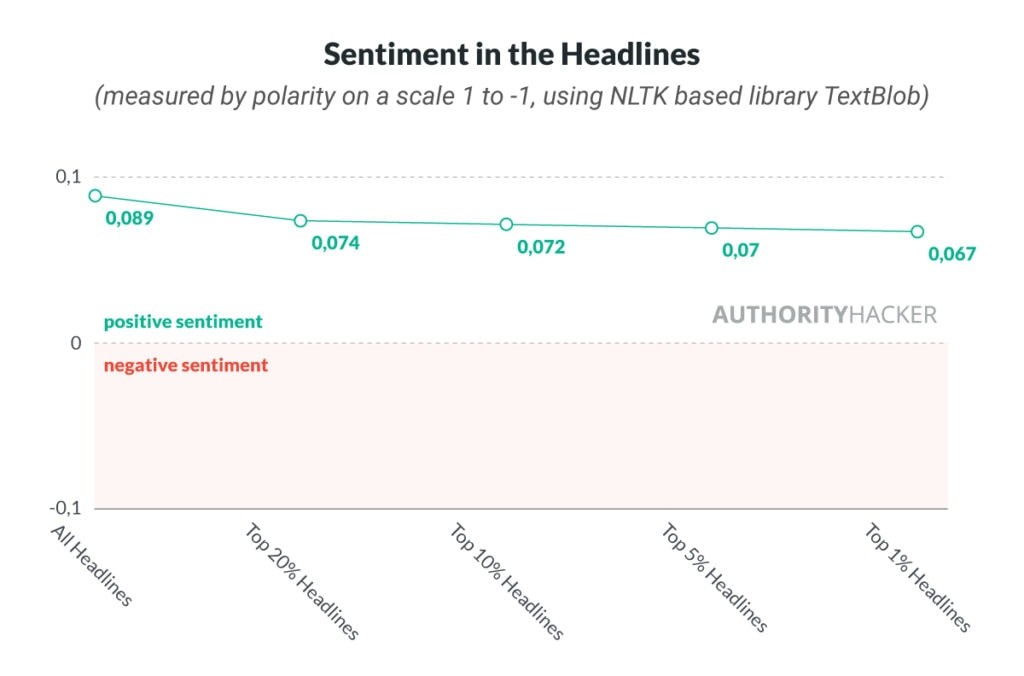
Basically a solid correlation. The more shared the headline, the less positive/more polarizing it is.
It’s important to note that TextBlob measures polarity on the scale of -1 to 1, with anything below zero being negative. Please, note the chart uses a smaller scale for better illustration.
So overall, the sentiment is barely positive, but rather decreasingly positive as we move up the from the average sample to the top performing headlines.
We also looked at subjectivity scores, again finding a nice correlation.
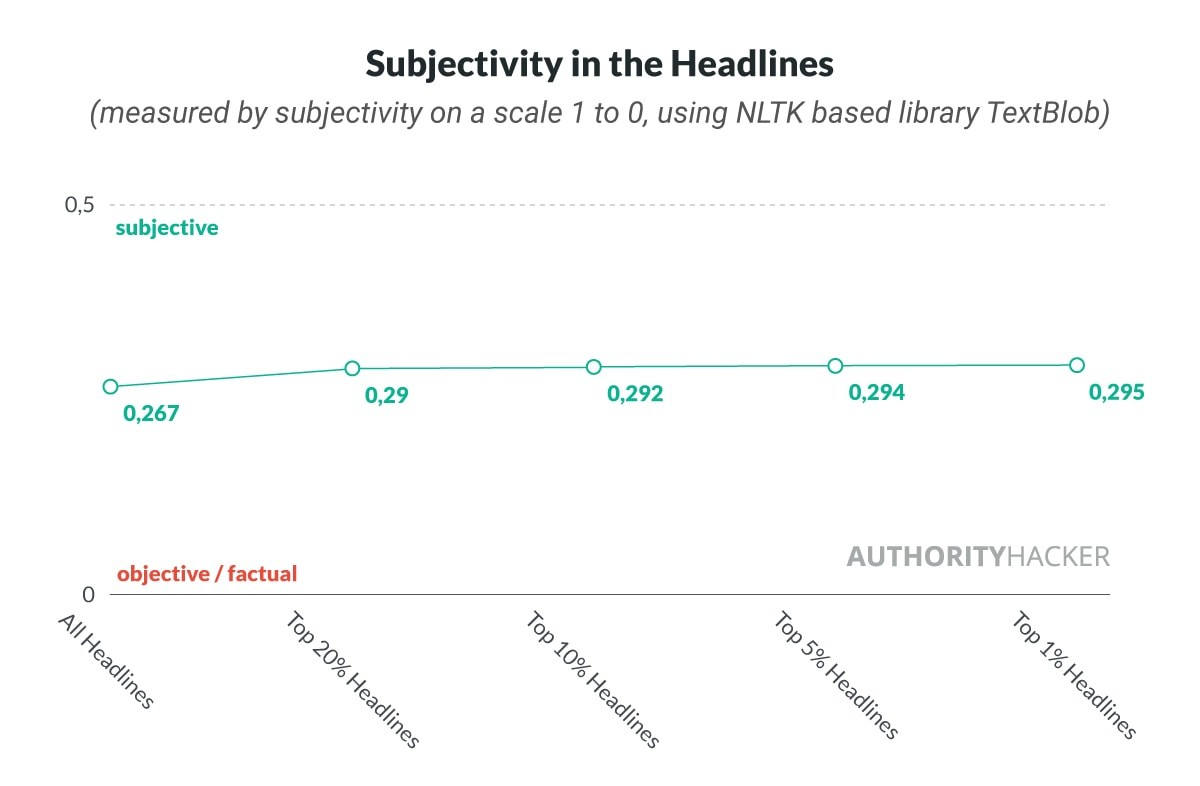
Subjectivity is measured on a scale of 0 to 1, with 0 being closest to objective, factual information and 1 being entirely subjective.
In the context of NLP basically means very related to speaking with authority, i.e. using “will” instead of “should” and so on, as explained before.
Key takeaways:
For me the key takeaway is that this confirms previous findings, namely that you should use a reasonably resolute tone (subjective) as people look for authority in their content.
Likewise, I wouldn’t bank on positivity too much, although it may depend on your target readership. Test your own hypotheses.
Do “Power Words” Work
The first time I’ve heard about power words was in my first job, an aggressive cold calling company, I joined fresh out of high-school.
The idea is that these words help you sell more.
In advertising, they’re quite a common concept too. Probably the first person to name specific power words was the advertising legend himself, David Ogilvy.
When I started writing some content, I would frequently read blogs like “use these 189 extremely effective power words.”

Because I normally read websites I consider legitimate, I trusted them. It never occurred to me that some of that might just be bullsh*t.
As you can see, the Ogilvy’s power words did not prove to correlate. I suspected that as some of those words (like “bargain,” or “hurry”) have become overused and sound sleazy today.
So I went on to test this hypothesis with other sets of words from popular highly ranked blog posts, only to find mixed results.
A great example is this post: “401+ Ridiculously Useful Power Words To Increase Conversion” by sumo.com (one of my favorite marketing blogs btw.)
While testing it (it didn’t validate) I got an idea that simply some of these words are garbage, while others will work.
Here’s what I did: I tested each word separately to filter out both, the garbage and the winners from that article. And here are the results:
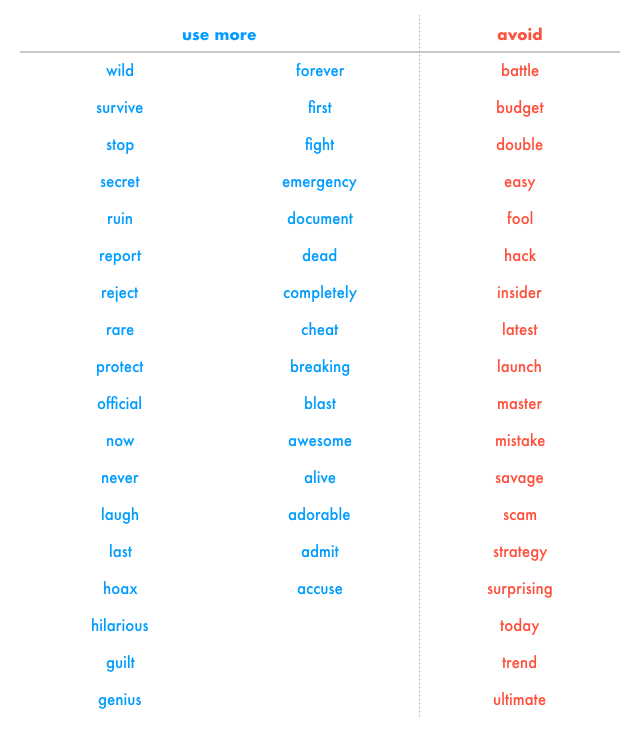
I have to say, I was looking for very strong correlations: as you can see I only got 53 words out of the whole 401+ “ridiculously useful” list.
Some of the other words may be effective or ineffective, but I couldn’t verify it with some solid confidence so I left them out.
Here’s a chart for your reference:
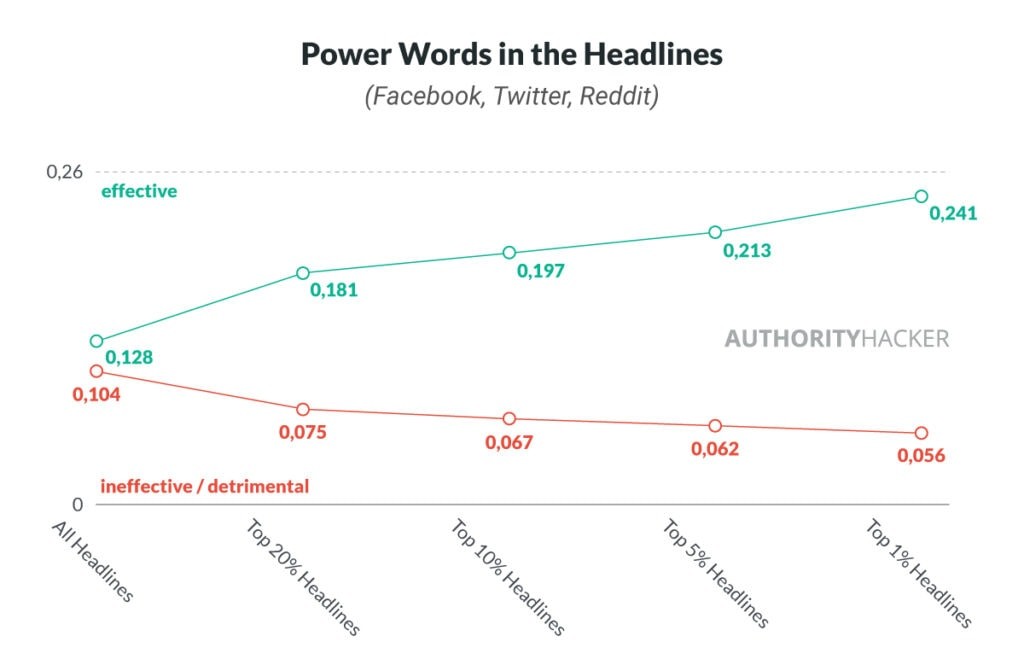
As you can see the list of “effective” words has some strong density moving up in the ladder.
Key takeaways:
Some power words work, others don’t. You should avoid “headline analyzers” and similar tools as they’re simply developed around a static list of such words.
Draw inspiration from headlines that are trending right now. Do your research. Try to be original but not too much. At the same time avoid what seems to be overused.
Ok Michal, That’s Cool. Now What
A lot of the recipes I gave you will massively improve the clickability, shareability and linkability of your content as they are.
But if you want to take it to the final stage, you need a testing environment.
For this, there is the cheap version, and the best version.
Onsite testing (cheap)
The cheap version is to use a plugin like Thrive Headline Optimizer to simply enter multiple headlines in your Wordpress dashboard.
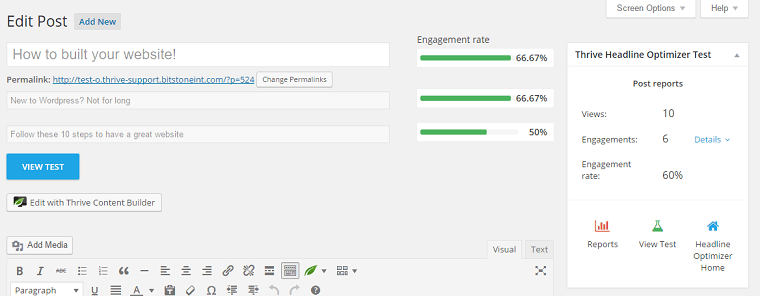
The plugin will only collect data from on site usage, so things like related post widgets, post feeds etc.
So, unless you have a decent amount of traffic, the data will be limited.
But so will the cost.
It can be a decent 80/20 approach for those who want better headlines but can’t be bothered with a lot of hassle and costs.
Using Facebook ads
If you are aiming for social engagement, Facebook ads are one of the best ways to test your headlines.
But throwing your content at cold traffic does get expensive, so my favorite way of doing it is to build hyper relevant but small retargeting audiences and test it on them.
For this, one easy way to build audiences is to use Pixel Caffeine by Adespresso.

Once you install the plugin, connect it to your Facebook ad account in the general settings.
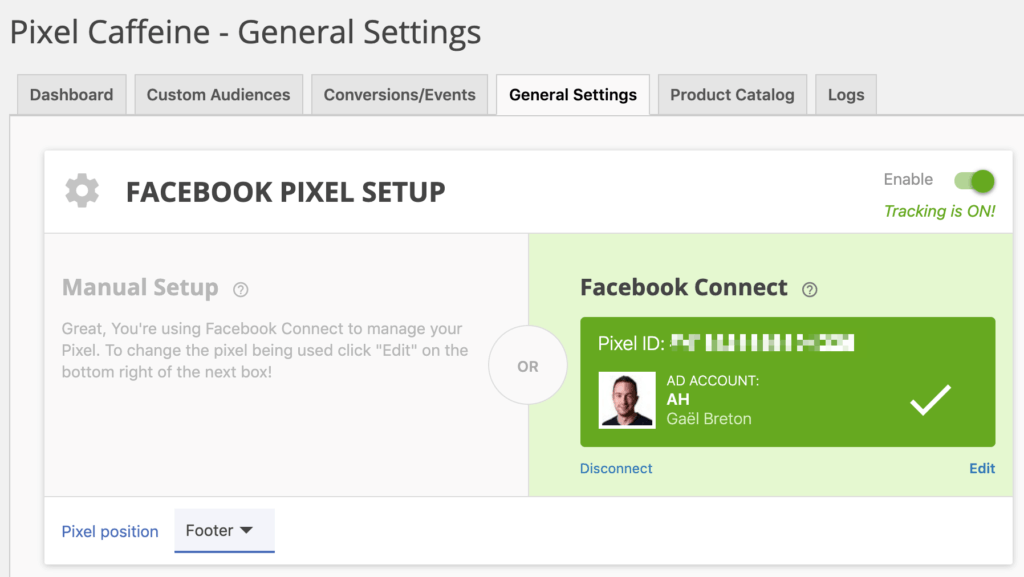
Then go in Custom audiences.
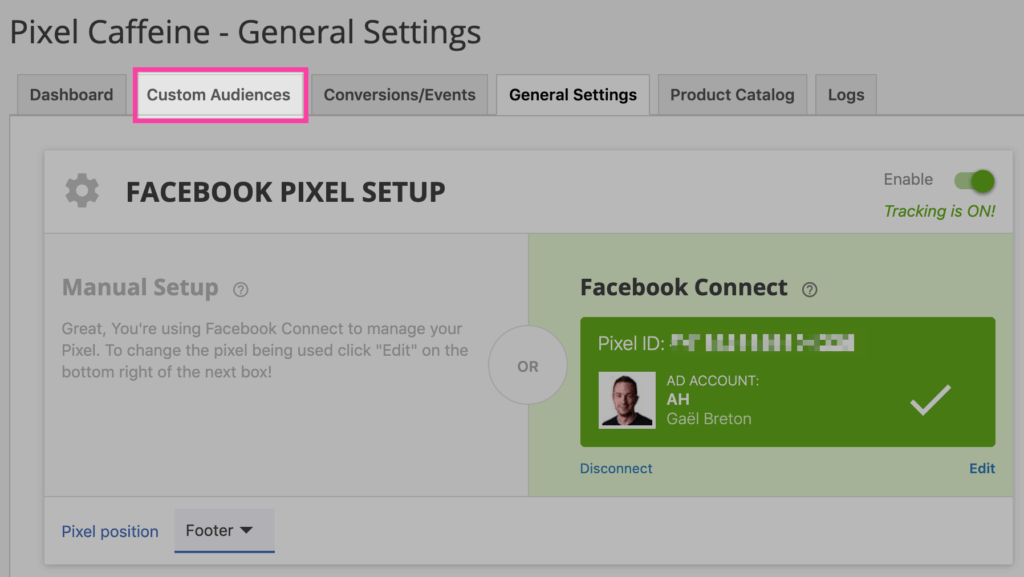
If you have less than 50,000 visitors per month, you probably want to retarget all your visitors using a simple 180 day retargeting audience like this:
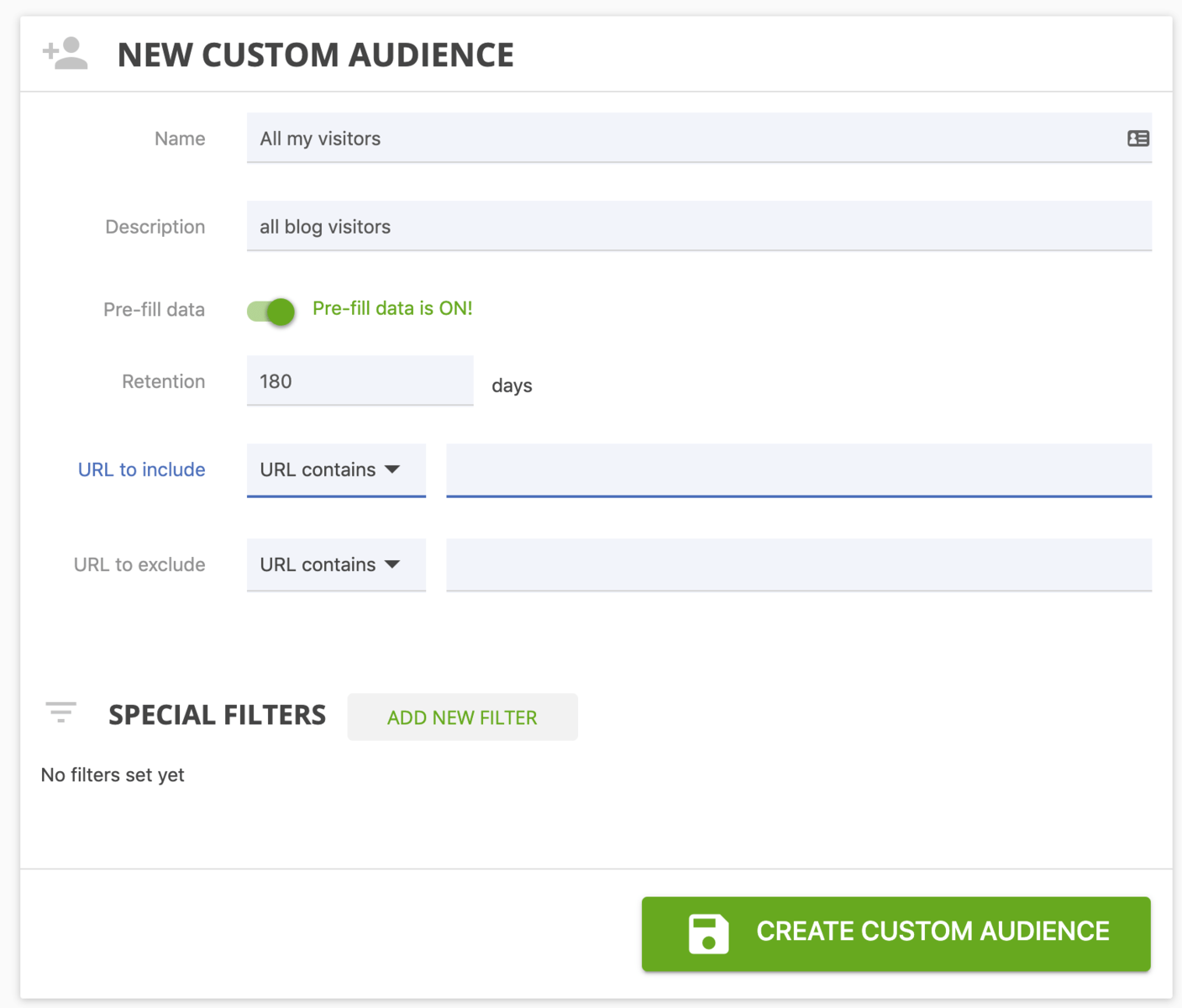
But if you have a bit more traffic, you can do like us and use special filters to build category specific audiences.

This will build highly engaged audiences you can use to test your headlines for cheap.
So I went ahead and opened Adespresso to try some headlines for this article based on what we have been learning earlier.
The only difference between all these ads will be the headline.
The goal is to establish how much of an impact the headline alone can have and whether it’s worth your time to optimize these.

This is what the ads look like on mobile (where they will be displayed the most)
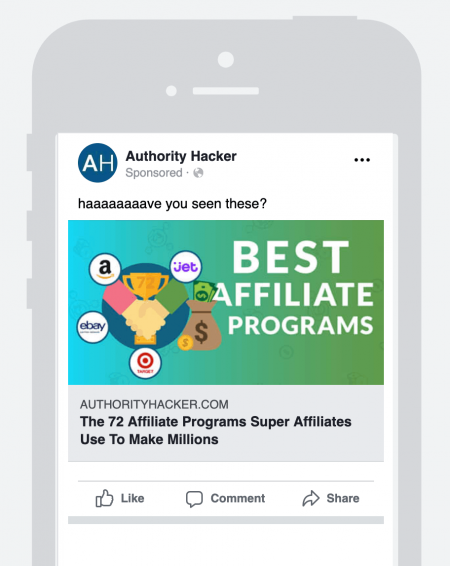
And the settings I’ve set in Adespresso

After letting the ads running their course, here are the results:
| Ad | Reaction rate | Share rate | Comment rate | CTR | Relevance Score | CPC (GBP) |
|---|---|---|---|---|---|---|
| Ad 1 | 4.5% | 0.9% | 0% | 3.4% | 8 | 0.418 |
| Ad 2 | 5% | 0.2% | 0% | 5.57% | 8 | 0.35 |
| Ad 3 | – | – | – | – | – | – |
| Ad 4 | 1.4% | 1.01% | 0.01% | 10.3% | 9 | 0.124 |
Unfortunately, ad 3 (the one about super affiliates making millions) got disapproved by Facebook.
Admittedly it was risky and clickbaity but worth a shot.
For the other ads, the results are quite interesting considering that the only difference is the headline of the article.
We can see the Game of Thrones headline got the most reaction and overall performed better than the negative / generic one in pretty much every aspect.
Thus reducing the cost per Click by 17% (That’s a lot already).
But the real winner here was ad 4 that focused on benefits “Quit your job” and the slight political angle / universality of the topic.
The cost per click was a whopping 71% cheaper than Ad1.
That’s a TON.
This is probably due to the fact that the share rate AND click through rate together were far higher than the other ads.
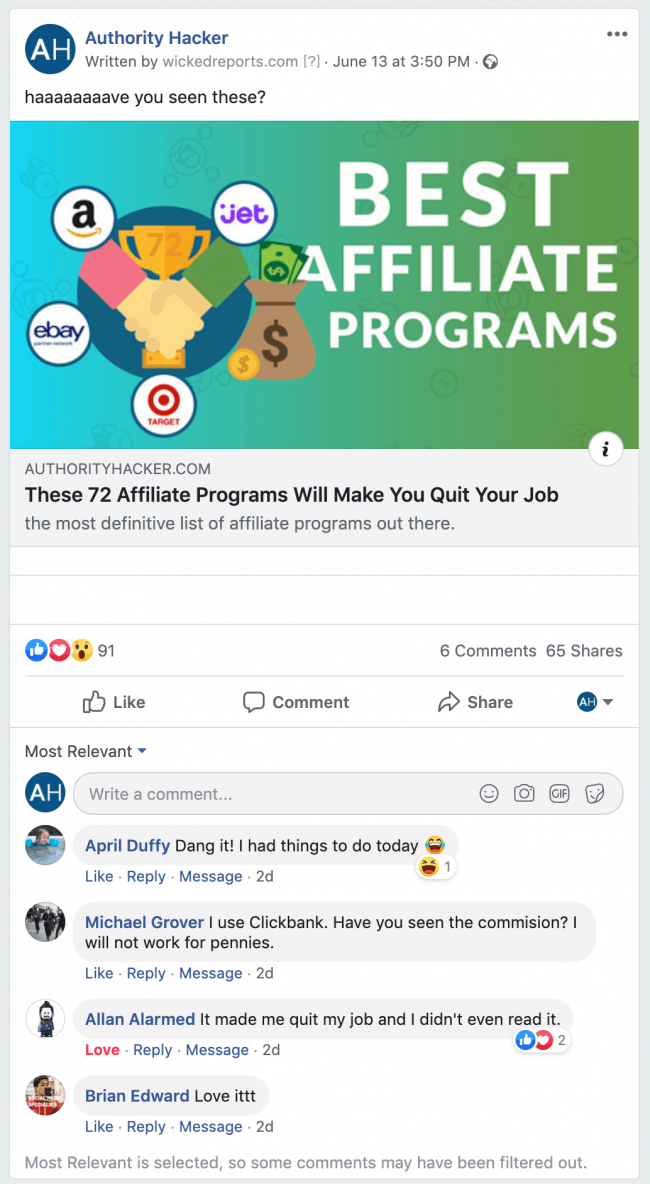
The final ad generated 91 reactions, 6 comments and most importantly 65 organic shares which resulted in 659 clicks which you will know is really good if you already run Facebook ads.
In the end, it means with the right headline, you can get the traffic $1,000 plus an average headline gets with just $296 in that case.
I can now take this data and update the post’s social meta data so it gets more engagement each and every time someone shares it.
This is the real power of running Facebook ads for headline testing.
Title tag A/B Testing
This one is a bit different given the fact that title tags have their own rules that will condition your search rankings and you should not ignore these.
But after all SEO considerations, the same engagement rules apply and should be use to write your title tags.
If you want to test them, tools like abrankings are affordable and give you acceptable data to make decisions from.
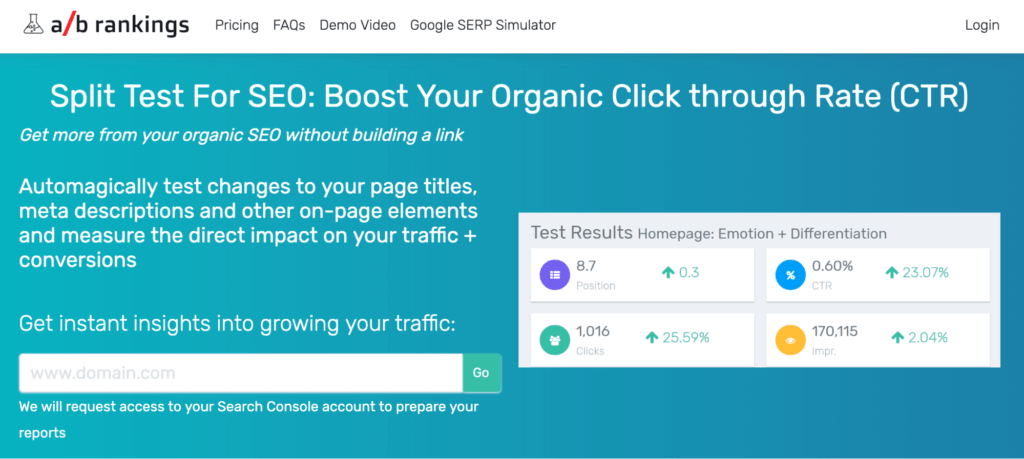
Conclusion
Writing headlines is a straightforward job. They should be simple, understandable, hint at a strong UVP and spark some curiosity and emotion.
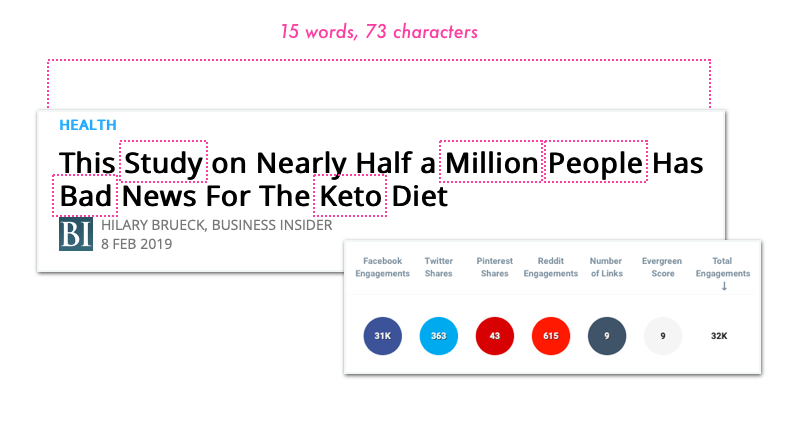
You shouldn’t overcomplicate it.
What you should do is avoid letting your research end here with this article. Each headline requires a very specific study of your audience.
There’s no surprise people like Ramit Sethi spend over 50% of their time on headlines alone.
It’s because it pays off.
Once you’re done with your research, generate 3-5 of your best ideas each from a different bucket (following what’s outlined in this piece) and test them out with one of the proposed or similar methods.
Collect your data and keep a log. Over-time you’ll start to get an idea what works specifically for you.
I believe this is the most sensible approach.




